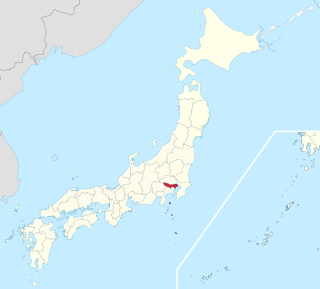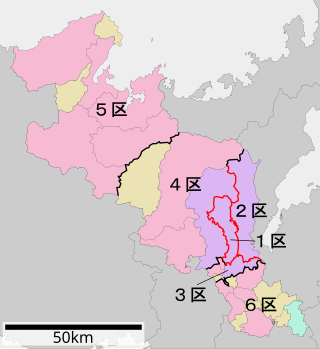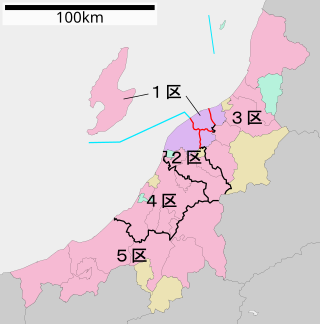
Gunma At-Large District is a constituency of the House of Councillors in the Diet of Japan. It consists of Gunma Prefecture and elects two Councillors, one per election.
The Kanagawa at-large district is a constituency of the House of Councillors in the Diet of Japan represented by six Councillors. It comprises the entire prefecture of Kanagawa and elects three Councillors every three years by single non-transferable vote.
The Okinawa at-large district is a constituency of the House of Councillors in the Diet of Japan. It consists of the entire prefecture of Okinawa and was created in 1970 following the agreement between US president Richard Nixon and prime minister Eisaku Satō on restoration of Japanese sovereignty over the Ryūkyū islands. Okinawa is represented by two Councillors electing one every three years.

Tokyo at-large district is an electoral district of the House of Councillors in the National Diet, the national legislature of Japan. The district was created in 1947 by the new Constitution of Japan and sent 8 members to the House from 1947 until 2007. From 2007 until 2016, this district sent 10 members to the House, and from 2016 onwards, the district has sent 12 councillors to the House, making it by far the largest constituency in the House of Councillors.

Tochigi At-Large District is a multi-member district of the House of Councillors in the Diet of Japan. It consists of Tochigi Prefecture and elects two Councillors, one per election.
The Hokkaido at-large district is a constituency of the House of Councillors in the Diet of Japan. It consists of the prefecture (dō) of Hokkai[dō] and is represented by six Councillors electing three at a time every three years by single non-transferable vote for six-year terms. In the election period from 2019 to 2022, Hokkaido's Councillors are :
Tokushima at-large district was a constituency of the House of Councillors in the Diet of Japan. It consists of Tokushima Prefecture and elects two Councillors, one every three years by a first-past-the-post system for a six-year term. In the first election in 1947, Tokushima like all districts used single non-transferable vote to elect both its Councillors in one election.

Aichi 6th district is a constituency of the House of Representatives in the Diet of Japan. It is located in Aichi and consists of the cities of Seto and Kasugai. The cities are just north of Nagoya and a part of the Chūkyō Metropolitan Area. Before the 2022 redistricting, the 6th consisted of Kasugai, Inuyama and Komaki. As of 2012, 420,807 eligible voters were registered in the district.
The Nagasaki at-large district is a constituency of the House of Councillors in the Diet of Japan. It consists of Nagasaki Prefecture and elects two Councillors, one every three years by a first-past-the-post system for a six-year term. In the first election in 1947, Nagasaki like all districts used single non-transferable vote to elect both its Councillors in one election.

Kyōto 3rd district is a constituency of the House of Representatives in the Diet of Japan. It is located in South central Kyoto and consists of Kyoto city's Fushimi ward, the cities of Mukō and Nagaokakyō and the town of Ōyamazaki. As of 2012, 345,260 eligible voters were registered in the district.

Hokkaidō 5th district is a constituency of the House of Representatives in the Diet of Japan. It consists of Atsubetsu ward in Hokkaido's city of Sapporo and Ishikari Subprefecture without Sapporo. As of 2009, 453,752 eligible voters were registered in the district.

Niigata 5th district is a single-member electoral district for the House of Representatives, the lower house of the National Diet of Japan. It is located in the central, Chūetsu region of Niigata and covers parts of Nagaoka City, the cities of Ojiya, Uonuma, Minami-Uonuma as well as the former Minami-Uonuma County that, as of 2012, only has one remaining municipality: Yuzawa Town. As of September 2012, 282,904 voters were registered in Niigata 5th district, giving its voters above average vote weight.

Shiga 2nd district is a single-member electoral district for the House of Representatives, the lower house of the Japanese National Diet, located in Eastern Shiga Prefecture.

Kumamoto 4th District is a current single-member electoral district for the House of Representatives, the lower house of the National Diet of Japan. It is located in Kumamoto and since 2017 covers roughly the Southern half of Kumamoto.

Kagoshima 2nd district is a single-member electoral district of the House of Representatives, the lower house of the National Diet of Japan. The district covers two different parts of Kagoshima Prefecture. On the main island of Kyushu, it covers most of the Satsuma Peninsula; this includes the cities of Makurazaki, Ibusuki, Minamisatsuma, and Minamikyūshū, as well as the former municipalities Taniyama City and Kiire Town, which are now a part of the capital Kagoshima City. The district also includes Ōshima Subprefecture, which covers the Amami Islands more than 300 kilometres to the south, which includes the city of Amami. In 2021 the district had 337,660 eligible voters.
Hyogo 8th district, also referred to as Hyōgo hachi-ku (兵庫8区), is a constituency of the House of Representatives in the Diet of Japan. It is located in southwestern Hyōgo and consists of the city of Amagasaki. As of September 2015, 379,207 eligible voters were registered in the district. It is one of the 48 districts in the Kansai region that form the Kinki proportional representation block.
Hyogo 2nd district, also referred to as Hyōgo ni-ku (兵庫2区), is a constituency of the House of Representatives in the Diet of Japan located in southwestern Hyogo Prefecture. The district consists of the Hyōgo, Kita and Nagata wards of Kobe and, after redistricting in 2017, a part of Nishinomiya. As of September 2015, 357,643 eligible voters were registered in the district. It is one of the 48 districts in the Kansai region that form the Kinki proportional representation block.
Hyogo 1st district, also referred to as Hyogo No.1 district and Hyōgo ichi-ku (兵庫1区) in Japanese, is a constituency of the House of Representatives in the national Diet of Japan. It is located in southwestern Hyogo Prefecture and consists of the Chūō, Nada and Higashinada wards of Kobe. As of September 2015, 378,434 eligible voters were registered in the district. It is one of the 48 districts in the Kansai region that form the Kinki proportional representation block.

Yamaguchi 3rd district (山口県第3区) is a single-member electoral district for the House of Representatives, the lower house of the National Diet of Japan. It is located in Mid-Western Yamaguchi and consists of the cities of Ube, Hagi City, San'yō-Onoda, Mine, Yamaguchi and Abu.

Miyagi Prefecture 6th District was an electoral district for the Japanese House of Representatives. The district was established In 1994 as a single member district from most of Miyagi 2nd district.